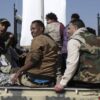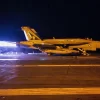“The hands of all parties in the region are on the trigger,” warned Iranian Foreign Minister Hossein Amir-Abdollahian last week, amid reports that Tehran had sent a back-channel message to Washington that an Israeli ground invasion of Gaza represents a redline.
Most observers might immediately think of Hezbollah as Iran’s primary means of responding should the red line be crossed. With an estimated 150,000-missile arsenal in south Lebanon and thousands of battle-hardened commandos, Hezbollah does indeed pose the most immediate threat to Israeli and US interests in the region. Tehran’s ability to project power across the Middle East is, however, much broader.
Like Israel, Saudi Arabia, the United States’ second most important regional ally, also has a militant, Iranian-backed proxy on its southern doorstep. The armed Houthi movement, Ansarallah, seized control of northern Yemen, including Hodeida, the country’s largest Red Sea port, in 2014. At that point, Houthi relations with Iran were fairly loose, but over the course of Yemen’s almost decade-long civil war, the two parties’ interests became tightly interwoven.
The Houthi leadership, otherwise isolated, became dependent on Tehran as the group’s sole international backer. For Tehran, the Houthis serve as a convenient means to harass Saudi Arabia, their Persian Gulf rival, with Iran providing, among other things, strategic guidance and technical assistance that has allowed the Houthis to dramatically advance their missile and drone capacities. Especially important today is the Houthis’ ability to threaten the 10% of global trade that passes through the Red Sea, providing Tehran with leverage to extract costs from the United States and Israel’s other Western backers if it feels the need to raise the stakes.
On Oct. 10, Houthi leader Abdumalik al-Houthi explicitly issued such a threat, warning that his forces would attack international maritime traffic in the Red Sea with drones and rockets if the United States intervened militarily in the Gaza war. He said the group was fully prepared to do so and was coordinating with other members of Iran’s so-called axis of resistance in Lebanon and Iraq. The Houthis have proven their ability to target ships in the Red Sea, having previously damaged both military and cargo vessels passing offshore.
Ten days after al-Houthi’s public threat, the Pentagon said a US Navy warship operating in the northern Red Sea had intercepted three cruise missiles and several drones launched from Yemen and flying north along the coast. A senior Houthi official later claimed that Israel had been the target, with Houthi forces having reportedly developed rockets that can reach the Negev Desert and Eilat in Israel’s south.
While potential Houthi strikes against Israel are unlikely to pose a serious military threat, were a Houthi missile or drone to evade Israeli and US aerial defense systems, the symbolism would be immense for the Houthis’ domestic audience. Among the few things that unite Yemenis of all stripes is their support for the Palestinian struggle, in which regard the Houthis are particularly fervent. The group regularly stages massive rallies in support of Palestine and has explicitly included the Palestinian cause in its revolutionary and anti-imperialist sloganeering. Also of note, the group’s rhetoric often conflates Israel and the United States as one and the same, with both portrayed as colonial powers trying to impose their hegemony on the region.
Riyadh also appears to be suffering fallout over the Israel-Hamas war vis-a-vis the Houthis. Riyadh led the regional coalition that launched a military intervention against the Houthis in 2015 and has since been stuck in the quagmire that is Yemen. Riyadh has desperately wanted to exit the war for years, but Saudi-Houthi talks on a comprehensive cease-fire that had recently shown promise were suddenly suspended after Israel began its aerial bombardment of Gaza earlier this month.
While the Houthi cruise missiles and drones that the United States downed this month caused the Saudis to close the airspace over southern Najran and Abha for three hours, Riyadh’s reaction was otherwise fairly muted. The Saudi leadership, wanting to keep the door open for the Houthis to return to the negotiating table, likely prioritized maintaining cordial relations with the armed group over any concerns of it attacking Israel.
Riyadh also seems to be trying to insulate itself should the Israel-Hamas war spill over and draw in bigger players on both sides. Saudi Arabia and Iran reestablished ties in March with the help of Chinese mediation, and when the bloodied bodies of Palestinian children killed by Israel airstrikes began appearing on regional news channels this month, Iranian President Ebrahim Raisi and Saudi Crown Prince Mohammed bin Salman held their first call about the conflict. The next day, reports emerged of Riyadh backing out of US-sponsored normalization talks with Israel.
In the long run, however, one can imagine that when the optics allow it, the Saudis will be keen to return to talks to cement normalized relations with the region’s most robust military and sole nuclear power. This is particularly true in light of Iran’s current demonstration of the scope of its regional threat through the mass mobilization of its proxies.
In a pattern of escalation from which regional wars are born, should Israel launch a land invasion of Gaza, it appears likely that Hezbollah would enter the war from Lebanon. In response, should the United States — which has one aircraft carrier strike group in the Eastern Mediterranean and another on the way — directly enter the conflict, it would trigger the Houthis’ involvement, according to the group’s leadership.
World supply chains and markets were rocked in 2021 when a giant cargo vessel went adrift and blocked the Suez Canal for six days, costing the world economy an estimated $ 400 million per hour. A commensurate amount of global economic traffic could thus be in the Houthis’ crosshairs if the group joins the current war, with the economic ramifications in Europe and elsewhere accruing immediate costs for Israel’s allies.
Meanwhile, in Iraq and Syria, Iranian-backed groups have been harassing US military bases, highlighting Washington’s regional exposure. Secretary of State Antony Blinken upped the ante last Sunday, saying the US military would “respond decisively” if its troops in the region were attacked. And before dawn on Friday, US jets carried out strikes against “two facilities it said were used by Iran’s Islamic Revolutionary Guard Corps and affiliated groups in eastern Syria, marking a swift response to a series of recent local attacks that have injured 21 US personnel,” reported Jared Szuba for Al-Monitor.
In a rare hit in December 2021, the United States killed the Iranian ambassador to the Houthis, Hasan Irlu, with an airstrike. In regard to the Houthis, however, it is unclear how effective a US or Israeli military campaign might be. After more than eight years of being bombed by the region’s richest country, Saudi Arabia, which is backed by the world’s most powerful military, the United States, the Houthis have never been stronger.
The Houthi militia, once a parochial, ragtag operation with loose ties to Iran, is today a force to be reckoned with in global geopolitics, anchoring Iran’s axis in the Red Sea.
This article was published by the AL-MONITOR








